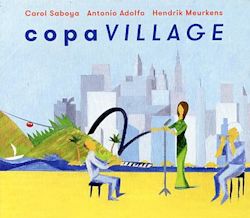1. The Girl from Ipanema/Garota De Ipanema
2. Copa Village
3. Show de Bola
4. O Boto
5. Como Se Fosse
6. Agua De Beber
7. Pois É
8. Pretty World
9. Two Kites
10. Nosso Mundo
11. Visão
Carol Saboya - Vocals
Hendrik Meurkens – Harmonica, vibes
Antonio Adolfo - Piano
Claudio Spiewak - Acoustic guitars, electric guitars
Itaiguara Brandão - Bass
Adriano Santos - Drums
André Siqueira - Percussion
Hendrik Meurkens was barely a toddler in Hamburg, Germany, when the bossa nova began to catch the musical wave in the late 50s and early 60s, to begin its
adoption and acceptance in North America. On the other hand, pianist Antonio Adolfo and his daughter singer Carol Saboya, were immersed in this musical
tradition in their native Brazil. Bringing these disparate individuals together for this recording Copa Village, was certainly musical
serendipity, as the results will attest.
The driving force and notional godfather of the bossa nova was Antonio Carlos Jobim and his songs are abundantly represented in this eleven-track session
starting with The Girl From Ipanema/Garota De Ipanema. There have been innumerable versions of this tune done over the years, but Carol Saboya’s
softly enchanting vocal seems to capture the essence of the number. Meurkens’ harmonica and Adolfo’s piano add subtle background support which completes
the charm of the arrangement. Meurkens and Adolfo wrote the title track Copa Village. It has a catchy melody on which Saboya provides a vocalese
overlay.
Jobim was a prodigious composer but not everything that he composed became a hit, even though the song may have captured the style and energy of the bossa
nova. For example O Boto (River Dolphin) has the typical Jobim cheerful disposition, and Saboya’s vocal carries the melody with charm, but it
never really caught on. However with Agua De Beber (Water To Drink) and Two Kites, both struck a chord that made them popular hits. On
the versions offered here, Saboya’s vocals express the playfulness of the numbers, despite her small voice and limited range.
Meurkens’ interest in the samba and bossa nova developed in the early 80s, when he spent several years in Brazil playing with local musicians, and
informing himself on the intricacies of the genre. If this can be regarded as an apprenticeship, it served him well, as listening to his own compositions
will attest. For example on Show De Bola (fig. Awesome) Saboya’s vocal is breezily inventive, and is showcased by Meurkens’ vibraphone excursions
that are sure-footed and rhythmic. For Nosso Mundo (Our World) the samba vibe is inventive and has a measured tension that Meurkens exploits with
an inventive harmonica solo. Saboya again has a lilting vocal that’s finely rendered.
The album is filled with the bossa nova’s rhythmic identification that is both confident and comfortable.
Pierre Giroux
